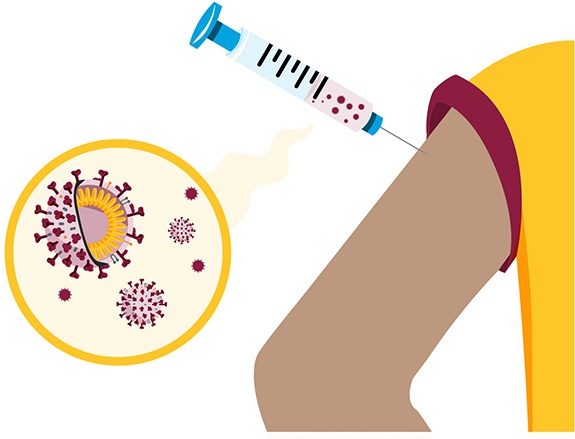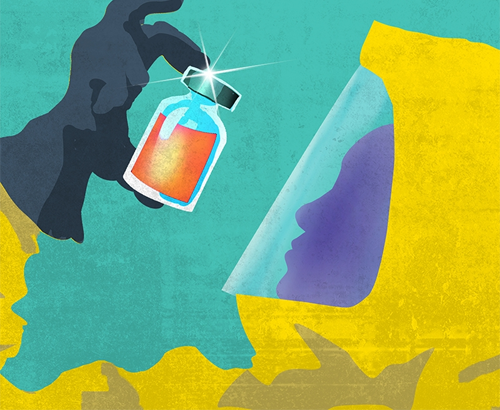Introduction
Vaccines | What vaccines do | Gaining immunity | Using vaccines | Herd immunity | Covid | R naught | Vaccine safety | Vaccine effectiveness | Vaccine waning rate
Overview
Vaccines
Vaccines are an important part of fighting illness in humans, livestock, and our pets. The first vaccines were developed in the late 1700s. Now, depending on where they live, people across the globe can use vaccines to protect them from severe disease against over 25 different pathogens.
What vaccines do
Vaccines are a way to train our bodies to fight specific viruses and other pathogens. They introduce our immune systems to parts of viruses, dead viruses, or viruses that are similar to ones we know cause major health problems. By being exposed to the vaccine, our bodies learn how to quickly recognize the pathogen, and which pathogen-fighting molecules, called antibodies, need to be made to win the fight. That way, if we encounter the real virus later, our bodies can fight it off more quickly, which means the symptoms will be milder or we won’t get sick at all.

Vaccines are the safest way to gain immunity to many pathogens.
Gaining immunity
There are only two ways that your body can learn how to fight a disease. It either has to fight the real pathogen and win, or it needs to be trained against that pathogen with a vaccine. Vaccines are the safest way for us to gain immunity against dangerous pathogens.
Using vaccines
But what effect do vaccines have when you look at the numbers? For some diseases, like smallpox and polio, vaccines have nearly wiped the pathogens off the globe. This has saved hundreds of millions of lives. For other diseases, like the seasonal influenza viruses, vaccines help millions of people avoid hospitalization every year.
Herd immunity
When a large portion of a population is vaccinated against a disease, that can help protect the people who are at risk of the disease but are not vaccinated. This community-based protection is called ”herd immunity,“ but it may be very hard to reach a level of protection that works for a specific pathogen. Vaccines are the only ethical way to reach herd immunity. With dangerous diseases that have no vaccines, a huge number of people would have to get sick, and many would have to die to reach herd immunity. Even then it is likely that the ”natural“ level of protection would still not be high enough to stop the spread.
Vaccines allow us to save lives by providing protection without severe disease. Reaching herd immunity is especially important for people who cannot be vaccinated because they have weakened immune systems. If most of the rest of a population gets vaccinated, it could potentially save their lives, but it could also save the lives of people who should not be vaccinated for medical reasons. In addition, vaccines may not work on newborn babies, whose immune systems are not yet well developed (and who are protected by antibodies from their mothers). Herd immunity can help protect those newborns.
Diseases
COVID-19
SARS-CoV-2, the virus that causes COVID-19
COVID-19 is caused by the virus SARS-CoV-2 (Severe Acute Respiratory Syndrome Coronavirus 2). Most people who are infected don’t show symptoms. Because of this, those people have a large impact on the spread of the virus. Those who do show symptoms may have fever or chills, tiredness, body aches, headaches, sore throat, loss of taste and smell, and digestive issues. People with more severe cases may have trouble breathing, chest pain, confusion, and problems staying awake. Though COVID-19 can affect people of any age, older adults and adults with other health problems are at the greatest risk of severe disease. COVID-19 spreads more easily than the flu and can lead to more serious illness in those who catch it. The best ways to fight the spread of the disease is through social distancing (staying more than 6 feet away from people outside of your household members), wearing a mask (some are more effective than others), and getting vaccinated against the disease.
Simulation values
R naught
R0, or ”R naught“ is a value used to measure the spread of a disease in a population. That value is equal to the number of people that an infected person is likely to spread the disease to. R0 is based on how easily the disease spreads, how much of the population is vaccinated, how dense a population is, and what behavioral precautions a population takes against spreading the disease. Wearing masks and distancing socially from one another can have a huge effect in protecting against specific diseases, especially those that are airborne.
Vaccine safety
All vaccines go through thorough safety tests before they are approved for widespread use. Vaccines that are approved are 99.99% safe. Generally, the only safety issues for approved vaccines are experienced by people with weakened immune systems, or by people who have an allergy to a vaccine ingredient. To learn more about vaccine safety, visit Do Vaccines Scare You?

Vaccines that are approved for widespread use have saved hundreds of millions of lives. Image by Doug Thompson of the US State Department.
Vaccine effectiveness
Vaccine effectiveness is a measure of how well a vaccine works. Some vaccines, such as the vaccine for polio, have very high levels of effectiveness, around 90% or more with at least two doses. Others, such as the vaccine for influenza, may be around 30 – 50% effective, depending on the year. Because influenza mutates so much, we have to try to predict what the virus will look like every year and plan far enough in advance to make a vaccine that works well enough to be approved. This prediction doesn’t always line up with how the virus mutates, which is why some years it may be more effective than others. The COVID-19 vaccines being distributed or developed have a wide range of effectiveness, from 50 to over 90%.
Vaccine waning rate
Vaccines work because our immune systems have memories. They learn how to fight off certain pathogens. However, immune memory does not last forever with some pathogens. Whether you fight off a disease or you are vaccinated for it, after enough time, your body can forget how to fight that pathogen. Tetanus and rabies vaccines are two examples, where you need to get regular boosters (every 10 years and 5 years, respectively) to protect yourself from the pathogen.
Keep up with new findings on the new coronavirus vaccines on our story page, COVID-19 vaccines.